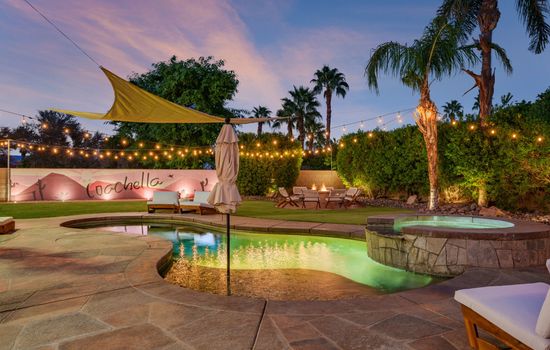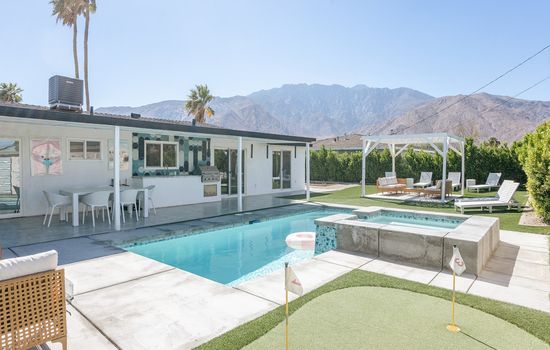There is no specific information available about the visitor center hours at Chuckwalla National Monument. However, you can check the latest updates on the Protect Chuckwalla National Monument website or contact the Bureau of Land Management for more details.
There is no entrance fee for Chuckwalla National Monument. However, the Corn Springs Campground within the monument has a $6.00 per night camping fee.
From Los Angeles, take I-10 E and CA-111 S, a 2.5-hour journey through the desert landscape to the rugged beauty near Mecca.
Parking at Chuckwalla National Monument is available near trailheads and campgrounds. Regular vehicles can use main road parking areas. No specific RV or motorcycle designations, but Corn Springs Campground has limited parking. Overnight parking permitted at campgrounds with a $6 fee.
Accessibility & permits
Emergency
- Cell service availability:None
Information not accurate?
Help us improve by making a suggestion.
In the heart of Southern California’s Colorado Desert, the newly designated Chuckwalla National Monument unfolds as a vast and resilient tapestry of desert landscapes. Spanning 624,270 acres, this protected area bridges the Sonoran, Mojave, and Colorado Deserts, creating a biodiversity hotspot teeming with life. Here, the rugged beauty of Painted Canyon and Box Canyon in the Mecca Hills area beckons adventurers, while the serene Corn Springs campground offers a tranquil oasis.
The monument is home to an array of unique flora and fauna, including the iconic Chuckwalla lizard, bighorn sheep, and desert tortoises. Resident and migratory birds such as Golden Eagles, Phainopepla, and Greater Roadrunners inhabit the diverse habitats, adding to the rich ecological tapestry. Petroglyphs etched into the rocks by the ancestors of the Cahuilla, Chemehuevi, Mohave, Quechan, and Serrano peoples underscore the deep cultural significance of this land.
As seasons change, the desert transforms; spring brings a burst of wildflowers, summer sunsets paint the sky with vibrant hues, and winter mornings offer crisp clarity. Visitors can explore the monument through various trails, discovering historical sites like the Patton training camps from World War II and ancient mining areas. For those seeking a deeper connection, ranger-led tours and cultural events honor the indigenous heritage and natural wonders of the area.
Nearby, the towns of Mecca and Desert Center offer a blend of local artisanry and rustic charm. Travelers should not miss the opportunity to engage with local outfitters and experience the unique hospitality of the region. Whether you are drawn to the monumental geological wonders or the intricate cultural narratives, Chuckwalla National Monument invites you to immerse yourself in its unparalleled desert beauty.
- Area (mi²)
- 974
- Established year
- 2025
Top 3 Facts about Chuckwalla National Monument
The area contains rock layers over 1.5 billion years old, highlighting its extensive geological history.
In this arid yet vibrant landscape, the iconic chuckwalla lizard and desert bighorn sheep roam freely, while the threatened Mojave desert tortoise finds refuge. Rare flora abounds, including California’s few saguaro cacti and the unique Mecca aster, with its lavender-blue flowers. Microphyll woodlands along desert washes host a multitude of species, and wildflowers like desert sunflowers and white desert lilies paint the landscape with color. This biodiversity hotspot is a haven for numerous bats, American badgers, and desert pupfish, offering an unparalleled wilderness experience.
Explore a landscape where rugged mountains meet gently sloping bajadas, with the Little Chuckawalla Mountains Wilderness featuring terrain carved by a network of washes. Here, layers of exposed rock span from over 1.5 billion to less than a million years old, creating a geological tapestry that winds through the Painted Canyon of Mecca Hills, where towering rock walls display vibrant hues against the Desert sky.
Family programs
- Junior Ranger
- Ranger-led Tours
- Self-guided Tours
- Workshops & Hands-on Activities
- Scavenger Hunts
- Night Sky & Astronomy
- Family Camping & Overnight
- Arts & Crafts
Travel Tips
Plan Ahead
Plan a few days in late September to explore the vast trails and scenic drives. Check for ranger-led hikes and events like the Full Moon Hike. Arrive early, visit the visitor center, and prepare for rugged terrain with rest stops and packed meals. Download maps and let someone know your itinerary.
Pack Appropriately
Pack a wide-brim hat, sunglasses, sunscreen, and ample water for daytime protection. Bring layers for cool nights and sturdy hiking shoes. For longer stays, include a first aid kit, navigation tools, and a portable charger. Check the season for additional gear needs.
Respect Wildlife
Wear sun protection, stay on trails, and avoid hiking during peak heat. Respect wildlife closures and avoid disturbing nests. Carry enough water and inform someone of your plans. Leave no trace to preserve the unique flora and fauna.
Stay Informed
Stay on marked trails, keep a safe distance from wildlife and ledges, and check weather conditions and park alerts. For emergencies, call 911 or park authorities. Be cautious near water and hot springs. Follow all signs and advisories to ensure a safe adventure.
Seasons
In spring, from March to May, temperatures range from 60°F to 80°F, ideal for hiking and birdwatching. Witness vibrant wildflowers, including desert sunflowers and Mecca aster, against a backdrop of rugged mountains and ancient petroglyphs. Mild weather makes it a perfect time to explore.
Summer brings scorching temperatures (100°F+), but also vibrant cactus blooms and star-filled nights. July’s full moon hikes offer a unique experience under the desert sky, though heat and monsoon rains make it a challenging time to visit.-align
Visit in fall, from October to November, when temperatures range from 60 to 80°F. Enjoy mild weather, scenic hikes through Ladder Canyon, and the annual Desert Dune Run event, set against a backdrop of vibrant desert landscapes. Ideal for outdoor enthusiasts.
Winter, from December to February, brings mild temperatures (40s-60s°F) and clear skies, ideal for hiking and wildlife spotting. Cooler days make it a perfect time to explore ancient trails and vibrant desert landscapes without the summer heat.
Information not accurate?
Help us improve by making a suggestion.
Where to stay
Frequently Asked Questions
Ready to dive into what Chuckwalla National Monument has to offer? Let’s tackle some of the burning questions you might have as you plan your visit!
-
The closest city to Chuckwalla National Monument is Mecca, which is located northeast of the monument in the Eastern Coachella Valley. Other nearby cities include Indio and Palm Springs.
-
Dogs must be on a leash no longer than 6 feet and owners must pick up after them. Dogs cannot be tied to trees or objects. Owners who do not follow these rules may be cited and fined.
-
You can park an RV in the area, but there are specific campgrounds to consider. Corn Springs Campground, near the wilderness, has nine sites suitable for RVs and trailers, with amenities like picnic tables, grills, water, and toilets. For more options, you can also look at nearby campgrounds like Wiley’s Well Campground, which has 15 sites for trailers and RVs.
-
Hike through scenic trails like Ladder Canyon and Painted Canyon Trail, which feature stunning rock formations, narrow slot canyons, and exhilarating ladder climbs. Enjoy wildlife watching to spot species like burro deer, desert bighorn sheep, and desert tortoises. Photography and camping are also popular activities in this diverse and biodiverse area.








